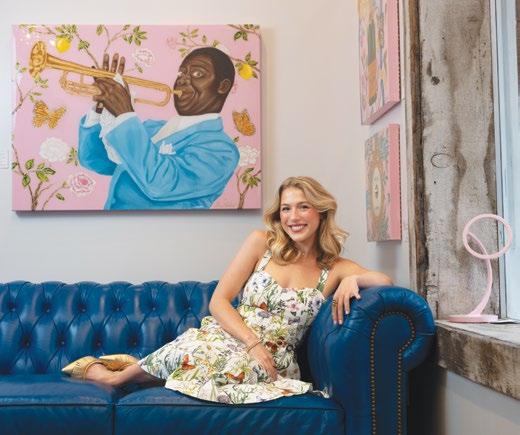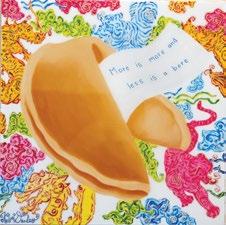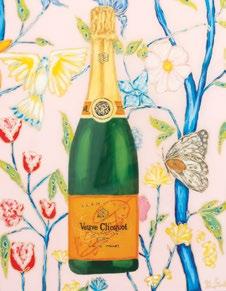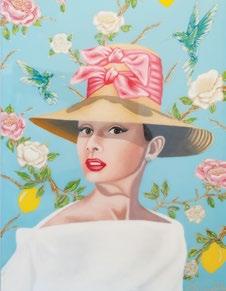
6 minute read
The Coronation of the Southern Queen of Baroque Pop
THERE’S NOTHING COY about a Kloe Donley painting.
To encounter a Kloe work is to be swept into a maximalist universe where glamour, modernity, and timelessness coexist in high-gloss harmony. It is all at once joyous, deliberate, unfiltered, and expertly composed.
Southern Baroque Pop
Kloe is something of a savant. At just 25 years old, she brings a visual language with the confidence and clarity of someone far more seasoned.
Kloe, the child of two public school teachers and a New Orleans native, grew up in the world of competitive gymnastics. As an artist, she is entirely self-taught with no early access to or connections in the art world. Since being bitten by the art bug in college, she has, and continues to, carve out a place in the art world, developing a style best described as Southern Baroque Pop.
Kloe’s work reclaims and reframes the language of pop, using saturated colors, glossy surfaces, and iconic imagery, while infusing it with the depth and complexity of Southern storytelling. Drawing on pop excess, baroque opulence, and Rococo theatricality, she builds exuberant and intimate compositions. Behind the sparkle lies a narrative rooted in memory, ritual, and place. It more than references culture. It performs it.
Her portraits of iconic women are lushly rendered in enamel-bright palettes and layered floral patterns, accessories, and symbols that flirt with camp but ultimately are grounded in reverence. These aren’t parodies; they’re devotions, altogether playful, precise, and immaculately staged.

Each canvas is finished with a resin glaze, another self-taught technique. The finish isn’t just for shine; it acts as a mirror, pulling you in with your own reflection, creating a feedback loop of desire, aspiration, and artifice.
Like any artist attuned to the visual world, she draws inspiration from those who came before—especially women who’ve carved space for beauty and boldness in contemporary art.
One inspiration, Ashley Longshore, redefined what it is to be a Southern woman in contemporary art. Her larger-than-life persona and maximalist aesthetic opened doors for a new generation of pop artists. If Ashley Longshore’s voice is loud and satirical, leaning into spectacle, Kloe’s is lush, playful, and emotional. Her work is equally vibrant, but more intimate and devotional, playful yet deeply personal, and unironically sincere in a way that feels fresh. If Ashley cracked the doors open, then Kloe walked through in goldtasseled kitten heels, bringing grace and grit.
“I paint what I like, what I want in my house,” Kloe says. Her works are meant to dazzle, be lived with, and to evoke happiness. In an art world preoccupied with detachment, her art’s joy is a radical act. Her choice of color is engineered for impact, brushwork is refined, and discipline and technique shows beneath whimsy; rigor and skill beneath the ribbons and resin.
Each work’s resin finishing requires heat guns, curing boxes, and total environmental control. Still, the final effect feels breezy, flirtatious, and radiant. It’s her greatest illusion: making the technical look instinctual and the excessive feel inevitable.
Kloe’s subjects—Hollywood starlets, legends, queens, country music royalty, drag queens, saints of popular culture, and popular objects—form a pantheon of feminine excellence. Her portraits transcend classical portraiture, focusing on identity, curated and layered with symbolism and hallmarks of sophistication and memory.

Kloe’s backgrounds, inspired by interior design, chinoiserie, or antique wallpaper, are built from deep dives into decorative art history. They incorporate historically accurate renderings of the most glamorous trappings of their period. These period motifs stand alone or become lush settings for a central icon. The result feels simultaneously vintage and modern, steeped in femininity.
Kloe treats her decorative pieces as structure. Like Hunt Slonem’s butterflies or Mickalene Thomas’s rhinestones, she uses the decorative as a serious visual language.
At home, there’s no separation between life and art. Her home, filled with dogs and floors coated with paint and late-night resin fumes, inspires her work. It is deeply personal. One Elvis painting was even based on her grandmother’s broken clock. “It still makes me think of her,” Kloe says. They’re not always grand narratives, but they evoke grand emotion.
The discipline, repetition, and resilience she developed during her time as a level 10 gymnast live on in her art. Indeed, being an artist is similar to being a gymnast; both demand discipline, solitude, and the quiet, repetitive toil that happens far from any audience. There’s competition, too, an undercurrent of comparison that can make the journey isolating. Just as she’d cheer on her competitors from the sidelines, she uplifts fellow artists with the same enthusiasm, celebrating their wins, encouraging their growth, and believing that one person’s success doesn’t diminish another’s.


Let Them Eat Color
All of this—the drama, the joy, the discipline, the heart—comes together in Let Them Eat Color, Kloe’s highly anticipated solo debut show, which opens on August 2 at the Orleans Gallery.
Kloe describes the show as having a “Bridgerton tea-party kind of vibe,” mixing regal imagery with her signature vivacity. Expect a cascade of pinks, teals, blues, bows, maximal ornamentation, text-based humor, and historical nods to icons, each reinterpreted through Kloe’s lens. It’s dopamine decor at its most refined.
Let Them Eat Color asks what it would mean, not only to see color, but to be consumed by it, to feast on it.
The title is invitation and provocation, nodding to Marie Antoinette while asking viewers to indulge. Donely will be your hostess, the gallery’s her parlor, and the paintings’ invitations to her feast asking: “Wouldn’t this look good in your life?”
And it would. It does. They radiate, seduce, and empower.
As the city spills into the streets for White Linen Night on August 2, Kloe Donley’s work will hold court—gilded, glimmering, and laughing softly with viewers.
And if you’re lucky enough to walk through those gallery doors, you may just find that you’re not looking at paintings anymore. You’re feasting on the color itself—alive, unafraid, and ready to be devoured.







